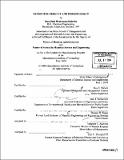| dc.contributor.advisor | Roy E. Welsch and Jack T. Dennerlein. | en_US |
| dc.contributor.author | Mortenson Schiveley, Sara Beth, 1975- | en_US |
| dc.contributor.other | Leaders for Manufacturing Program. | en_US |
| dc.date.accessioned | 2006-11-08T16:33:16Z | |
| dc.date.available | 2006-11-08T16:33:16Z | |
| dc.date.copyright | 2004 | en_US |
| dc.date.issued | 2004 | en_US |
| dc.identifier.uri | http://hdl.handle.net/1721.1/34758 | |
| dc.description | Thesis (M.B.A.)--Massachusetts Institute of Technology, Sloan School of Management; and, (S.M.)--Massachusetts Institute of Technology, Dept. of Materials Science and Engineering; in conjunction with the Leaders for Manufacturing Program at MIT, 2004. | en_US |
| dc.description | Includes bibliographical references (p. 66). | en_US |
| dc.description.abstract | Ergonomic injuries are not the result of acute events. An ergonomic injury develops gradually from continued actions combining force, motion repetition, posture, and duration. Because these injuries accrue over time, it is often difficult to determine their causes. Lacking a clear causal link, it is difficult to justify investments that are intended to prevent ergonomic injuries. A large computer manufacturer, Dell Inc, is targeting significant reductions in their factory injury rates. This thesis describes the evaluation of two desktop computer manufacturing facilities. As part of this work, OSHA logs from 2002 were analyzed, injury costs were collected, factory workers were surveyed, and biomaterials associated with ergonomic injuries were studied. The analysis of the OSHA logs determined that 70% of factory injuries were ergonomic in nature and that a majority of the ergonomic injuries occurred as a result of work in the computer assembly (build) area. The costs associated with ergonomic injuries were computed on a cost per box (CPB) basis, a common metric used throughout Dell factories to determine financial impact. In order to evaluate, improve, and monitor the ergonomic factors on the factory floor, an evaluation tool for product and process design was developed. This tool incorporates risk factors of force, motion repetition, and posture while determining ergonomic scores for products and process steps. Tool validation was achieved by comparing ergonomic scores with worker product preferences, as revealed by an employee survey. Currently, the ergonomic evaluation tool is being used by the Environmental, Health, and Safety (EHS) Department at Dell. A greater understanding of the causes behind ergonomic injuries, combined | en_US |
| dc.description.abstract | (cont.) with use of the evaluation tool, is contributing to Dell's efforts to continuously reduce the occurrence of ergonomic injuries and associated costs. | en_US |
| dc.description.statementofresponsibility | by Sara Beth Mortenson Schiveley. | en_US |
| dc.format.extent | 66 p. | en_US |
| dc.format.extent | 4042540 bytes | |
| dc.format.extent | 4047737 bytes | |
| dc.format.mimetype | application/pdf | |
| dc.format.mimetype | application/pdf | |
| dc.language.iso | eng | en_US |
| dc.publisher | Massachusetts Institute of Technology | en_US |
| dc.rights | M.I.T. theses are protected by copyright. They may be viewed from this source for any purpose, but reproduction or distribution in any format is prohibited without written permission. See provided URL for inquiries about permission. | en_US |
| dc.rights.uri | http://dspace.mit.edu/handle/1721.1/7582 | |
| dc.subject | Sloan School of Management. | en_US |
| dc.subject | Materials Science and Engineering. | en_US |
| dc.subject | Leaders for Manufacturing Program. | en_US |
| dc.title | Ergonomic product and process design | en_US |
| dc.type | Thesis | en_US |
| dc.description.degree | S.M. | en_US |
| dc.description.degree | M.B.A. | en_US |
| dc.contributor.department | Leaders for Manufacturing Program at MIT | en_US |
| dc.contributor.department | Massachusetts Institute of Technology. Department of Materials Science and Engineering | |
| dc.contributor.department | Sloan School of Management | |
| dc.identifier.oclc | 56713270 | en_US |
